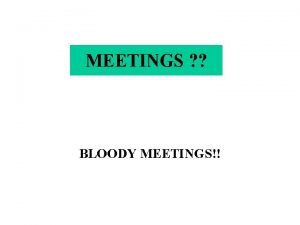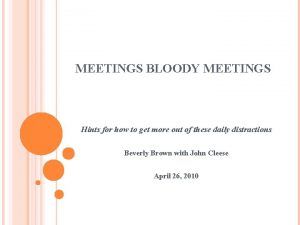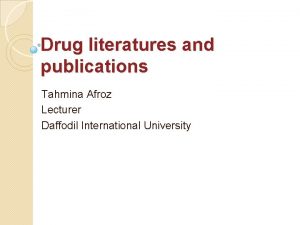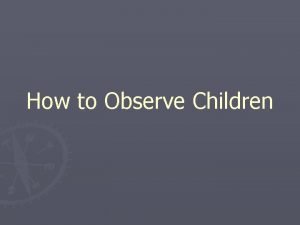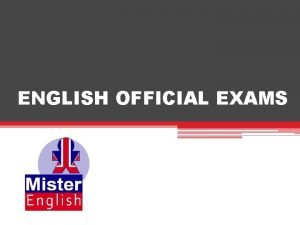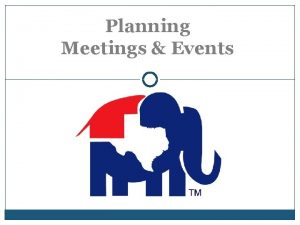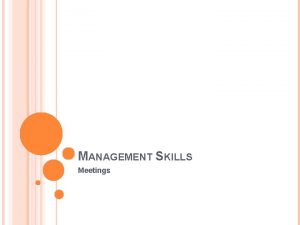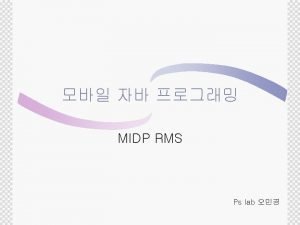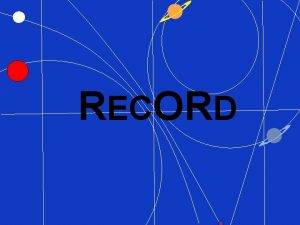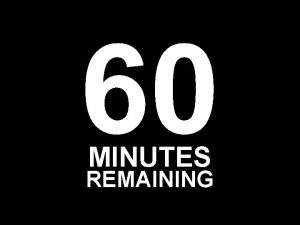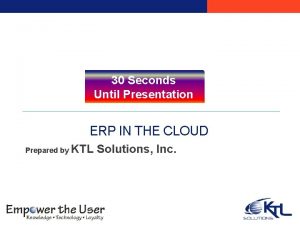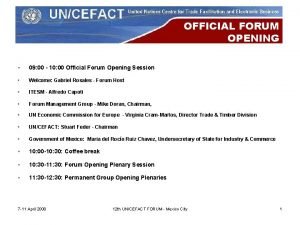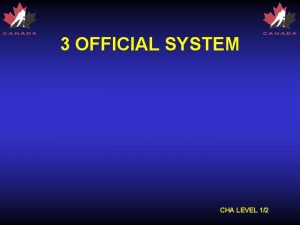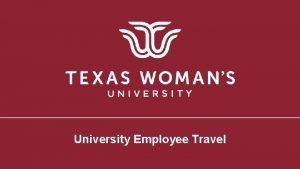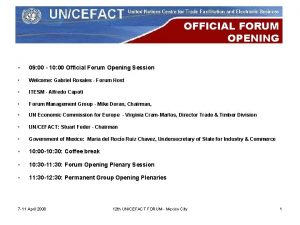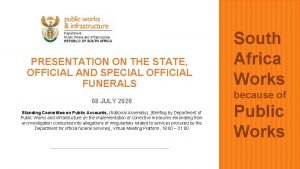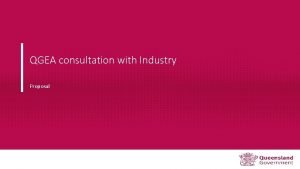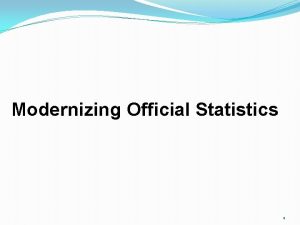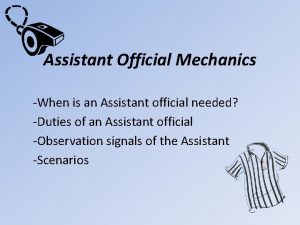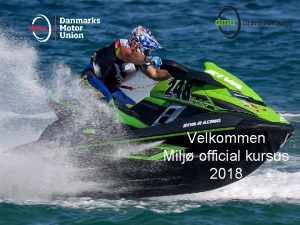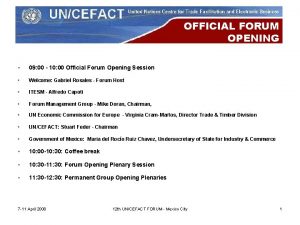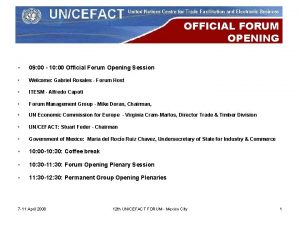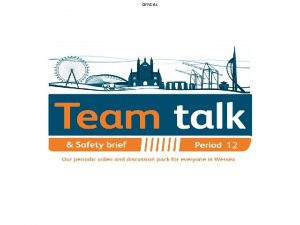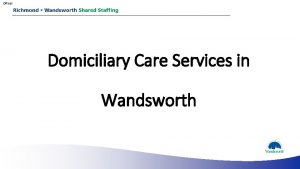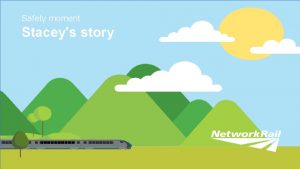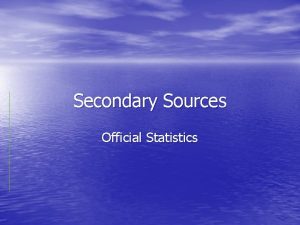Minutes Minutes The official record of meetings is















































- Slides: 47

Minutes

Minutes? The official record of meetings is called the minutes. It is a concise record of the decisions reached at a meeting. Minutes also give a record of the actions taken, remind participants of what has to be done, provide a historical record for the company, keep top management and others informed, and list who is responsible for recommendations and actions.

Minutes normally include: Time, date and place of meeting List of people attending (Present) List of absent members of the group (Apologies, Apology for absence) Approval of the previous meeting's minutes, and any matters arising from those minutes (Minutes) For each item in the agenda, a record of the principal points discussed and decisions taken (Report, Motion and Resolution) Time, date and place of next meeting (Next Meeting) Name of person taking the minutes

Effective Minutes should be concise, objective, accurate and easy to understand.

Business Report

Report, what is it? A report is a planned, organized, factual presentation of information prepared for a specific purpose and for a specific audience. Reports deliver essential information so that receivers make competent decisions, carry out the responsibility of the jobs, and further the goals of their

Internal VS. External Report Internal Report: distribute within organization—up, down, and across the organizational hierarchy (a system of organization in which people have higher and lower ranks). External Report: distribute outside the organization to clients, stockholders, government agencies, and the public.

Informal Report (Short Report) It is the most common form of business report. It is usually short 6 pages or fewer, and is generally written in a form of letter (as external report) or memo (as internal report).

Formal Report (Long Report) It is longer and more detailed than brief informal report. It required more extensive information gathering and is presented in a more stylized format. It is always presented objectively and relied on extensive details for documentation.

Formal Report Components: Title Page This page includes the full title of the report; the name and title of the person who prepared the report, the name of the person for whom it was prepared, and the date on which the report was submitted. p. 291

Formal Report Components (cont): Letter of Transmittal It is addressed to the person(s) who prepared the report , the board overview of report purposes, and states that the report is ready p. 292

Formal Report Components (cont): Table of Contents This page will be outlined in advance, but it must be typed last. It consists of a list of all the headings and subheadings in the report and the number of the page on which each section begins. List of Figures includes tables and figures in one list p. 293

Formal Report Components (cont): Executive Summary or Synopsis This section is a concise statement of the main points covered in the report. Think of it as a courtesy for the busy executive who will not have enough time to read your entire report. Normally Executive Summary provides more information than a Synopsis, which gives only a brief descriptive outline or general view of the report.

Formal Report Components (cont): Introduction Unlike the introduction to a college term paper, this section is not an opening statement leading into your main topic. Rather, it is a statement of 3 specific facts: A) The purpose of your report (what the report demonstrates or proves) B) The scope of your report (what the report does and does not include) C) The method by which you gathered your information (personal interviews, field research, questionnaires, secondary sources, etc. )

Formal Report Components (cont): Main Body of the Report (Body) It is the essence of your report. It is the organized presentation of the data you have accumulated.

Formal Report Components (cont): Conclusion This is the objective statement of what the report has shown. It sums up the results, outcome, decisions, or judgment reached after the writing of the report. Recommendations It uses to describe a course of action on the basis of the facts as presented in the study. p. 299

Formal Report Components (cont): Appendix This section consists of supplementary information, often in the form of graphs, charts, and diagrams which does not fit into the body of the report but which is essential to substantiate the data.

Formal Report Components (cont): Bibliography A listing of references used in preparing the report is required whenever printed material has been consulted. Entries are listed alphabetically by author’s last name. Proper format varies from field to field, so you should consult a manual or style sheet. p. 300

Characteristics of Formal and Informal Reports Formal Report Complex situation or project Numerous report parts, sections, and components Considerable research and detail Typically formal language Informal Report Routine or uncomplicated situation or one aspect of a larger problem Fewer parts, sections, and components Limited research and detail Typically informal

Sources of Information Primary Sources The findings from customer surveys, taste tests, product trials, interview, observations, and experiments. Secondary Sources Secondary information is based on primary information. For example, the researchers publish the findings in a professional journal, and a reader includes some of the information in report. The information from published journal is secondary information. Secondary materials include print or online materials, and video or audio recordings are released.

Proposal

What is proposal? A proposal identifies a need or a problem that affects the receiver and then offers a plan to meet the need or solve the problem. The objective of a proposal is to persuade the receiver to follow the course of action suggested by proposal. Proposals are prepared for reasons such as capturing new markets, developing new products or services, improving operation, and changing procedures. It can be use as both internal and external purpose. See sample: p. 269 -270

Effective proposal contains: The problem to be solved or need to be met The proposed solution The resulting benefits

Important Information for writing proposal The necessary background Reasons why resolving the problem is so important to the receiver Accurate, specific information about the proposed solution and its implementation (methods, timetables, costs, personnel, equipment, etc. ) Your qualifications for handling the problem


What is it? It is the quick transmission and distribution of information, letters and messages via Internet from one computer to another.

Effective E-mail should: Do not use only CAPITAL LETTER in typing message Always fill the “subject line” which is the topic that you writing about Avoid to use too many acronyms in business message (esp. the formal one), some of acronyms can be use in informal e-mail message such as ASAP, BRB, GTG, TTUL.

FAX (Facsimile)

What is it? It is a tool in instant business and private communication by using the telephone lines. It is an easy, safe, inexpensive way to transmit business message to another fax anywhere in the world in minutes.

Resume http: //www. youthcentral. vic. gov. au/

How to write a resume A resume - sometimes called a 'Curriculum Vitae' or 'CV' - is a summary of your skills, education and work experience. A good resume demonstrates how your skills and abilities match up with the requirements of a job.

How long should it be? Resumes give you the opportunity to sell yourself to a potential employer. A resume is not an exhaustive list - if it's too long it probably won't get read at all. The best resumes are usually no longer than one or two pages.

Do I need to change it every time? You should change your resume with every job application so that it lists the skills and experiences you have that are most relevant to the job you're applying for. A tailored resume will be much more successful than a generic one, even though it means more preparation.

What if I don't have much experience? While things like your academic record and work experience are typical ways to show suited you are to a particular job, these are not the only things you should include. There are other ways to demonstrate that you are the right person for the job, including your: Personal traits - you're an honest worker, you enjoy being part of a big team Strengths - things you're good at or enjoy Experiences - volunteering or extracurricular activities Key responsibilities and achievements - any awards or recognition that you've received

How do I organize the information? The structure of your resume will vary depending on your work experience and education and training background. A resume usually sets out information in a reverse order. Your most recent work experience and study details should be first on the list.

What do I include? Personal details Full name and contact details including address, telephone number(s) and email address.

What do I include? Education and training A summary of your education and training history, starting with your most recent studies, making sure you include all training that's relevant to the job you're applying for.

What do I include? Employment history Start with your most recent work history and work backwards chronologically, listing the name of the employer, your job title, the dates you worked there, and your responsibilities, tasks and achievements. Make sure you include everything that's relevant to the job.

What do I include? Skills and abilities A list of the things you're good at. These can be general skills or skills specific to a particular job. List them under broad headings such as "Communication" and "Teamwork".

What do I include? Career objective (optional) Tell the employer what type of job you want end up with; this shows that you've given thought to your future career.

What do I include? Interests (optional) A list of your hobbies and interests; this gives employers more information about you and also shows other areas of your life where you've gained experiences such as teamwork and commitment.

What do I include? Referees List people who can talk about how good a worker you are. Make sure you get their permission before including them on your resume. List their name, company name occupation, and contact details.

Resume checklist After you've written your resume, and before sending it, go through this checklist: Proofreading - Make sure there aren't any spelling mistakes, typos or grammatical errors. Tailoring - Make sure everything you mention shows how well-suited you are for the job you're applying for. Presentation - Make sure the resume is well laid out, easy to read and printed on clean, white paper in a standard font (like Times New Roman, Arial or Verdana) and at a standard size (10 or 12 point). Detail - Make sure you've provided specific examples of your achievements and how you've used the skills you have.

Cover Letter http: //www. youthcentral. vic. gov. au/

How to write a cover letter A cover letter is not a job application - it's a short and specific letter that should always accompany resume, folio or any other application documents that you send to a prospective employer. You might be applying for a specific, advertised job or you might be marketing yourself for possible future work. Either way, your cover letter aims to: Introduce you Highlight your key selling points (skills, experience or achievements) Encourage the reader to discover more about you through your resume Finish with a 'call to action', e. g. requesting an interview (if it's

Tailor your cover letter The key aim with any cover letter is to make it as personal as possible. This means addressing your letter to a real person (not 'To Whom It May Concern') and a specific job. Avoid the temptation to send out a generic, 'one-size-fits-all' letter. This means a bit of extra work. You may need to call an organisation and find out how you need to address your letter. Spend some time researching a company (using the internet is often the easiest way to do this) so that you can make your letter relevant to a specific job or a particular company.

What to include You need to demonstrate to a potential employer that you understand the job requirements and can do the job. So include the skills and experiences you have that match the job description. You also need to show that you are enthusiastic and have a positive attitude towards the role and the hiring company.
 Meetings bloody meetings
Meetings bloody meetings Meetings bloody meetings 5 points
Meetings bloody meetings 5 points Teams
Teams Official compendia
Official compendia Example of running record observation of a child
Example of running record observation of a child There are 60 minutes in ……... hour
There are 60 minutes in ……... hour Quá trình desamine hóa có thể tạo ra
Quá trình desamine hóa có thể tạo ra Công của trọng lực
Công của trọng lực Khi nào hổ con có thể sống độc lập
Khi nào hổ con có thể sống độc lập Thế nào là mạng điện lắp đặt kiểu nổi
Thế nào là mạng điện lắp đặt kiểu nổi Các loại đột biến cấu trúc nhiễm sắc thể
Các loại đột biến cấu trúc nhiễm sắc thể Bổ thể
Bổ thể Vẽ hình chiếu đứng bằng cạnh của vật thể
Vẽ hình chiếu đứng bằng cạnh của vật thể Thế nào là sự mỏi cơ
Thế nào là sự mỏi cơ Phản ứng thế ankan
Phản ứng thế ankan Thiếu nhi thế giới liên hoan
Thiếu nhi thế giới liên hoan Bài hát chúa yêu trần thế alleluia
Bài hát chúa yêu trần thế alleluia điện thế nghỉ
điện thế nghỉ Một số thể thơ truyền thống
Một số thể thơ truyền thống Trời xanh đây là của chúng ta thể thơ
Trời xanh đây là của chúng ta thể thơ Các số nguyên tố
Các số nguyên tố Tỉ lệ cơ thể trẻ em
Tỉ lệ cơ thể trẻ em Fecboak
Fecboak đặc điểm cơ thể của người tối cổ
đặc điểm cơ thể của người tối cổ Các châu lục và đại dương trên thế giới
Các châu lục và đại dương trên thế giới Sơ đồ cơ thể người
Sơ đồ cơ thể người ưu thế lai là gì
ưu thế lai là gì Các môn thể thao bắt đầu bằng tiếng bóng
Các môn thể thao bắt đầu bằng tiếng bóng Tư thế ngồi viết
Tư thế ngồi viết Cái miệng nó xinh thế
Cái miệng nó xinh thế Hát kết hợp bộ gõ cơ thể
Hát kết hợp bộ gõ cơ thể Mật thư tọa độ 5x5
Mật thư tọa độ 5x5 Tư thế ngồi viết
Tư thế ngồi viết Voi kéo gỗ như thế nào
Voi kéo gỗ như thế nào Thẻ vin
Thẻ vin V cc
V cc Thơ thất ngôn tứ tuyệt đường luật
Thơ thất ngôn tứ tuyệt đường luật Các châu lục và đại dương trên thế giới
Các châu lục và đại dương trên thế giới Từ ngữ thể hiện lòng nhân hậu
Từ ngữ thể hiện lòng nhân hậu Khi nào hổ con có thể sống độc lập
Khi nào hổ con có thể sống độc lập Thế nào là hệ số cao nhất
Thế nào là hệ số cao nhất Diễn thế sinh thái là
Diễn thế sinh thái là Vẽ hình chiếu vuông góc của vật thể sau
Vẽ hình chiếu vuông góc của vật thể sau Ng-html
Ng-html Phép trừ bù
Phép trừ bù Lời thề hippocrates
Lời thề hippocrates Thang điểm glasgow
Thang điểm glasgow đại từ thay thế
đại từ thay thế
